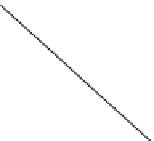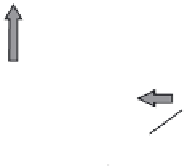Geoscience Reference
In-Depth Information
The data obtained show that the annual vertical displacement is no
more than about 7 cm. In a way this is small, since COLE can reach 13
per cent, which corresponds to 26 cm for a 2-m deep soil. But the soil is
itself heavy, which limits its swelling. In general, the lateral displacement
is still less. Also, the latter is totally absorbed at the scale of one metre
or a few metres by the closing of wide vertical cracks. Thus the isotropic
character of swelling of a sample is not found in the field.
The vertical shrinkage has been used to determine the water content
and thus for irrigation planning. Experimentally, a correlation coefficient
of 0.85 was found between the two values (Cheng and Pettry 1993).
The principal difficulty is linked to the fact that the displacement of
the metal rods corresponds to the variations in matrix water (intra-
aggregate), whereas the plant-available water includes the water of
the fissural porosity too (Ozier-Lafontaine and Cabidoche 1995). The
calculations of water reserve done on the basis of swelling-shrinkage
and those effected through daily monitoring of the hydric balance give
the same result for a relatively dry soil.
Tropical rains of high intensity penetrate these clayey soils slowly
from the surface. Thus the water has time to flow laterally to the
micro-depressions. There it infiltrates rapidly into the larger cracks to be
distributed more slowly in the soil mass by using the structural porosity
(between aggregates) and the matric porosity (within aggregates).
During evaporation, this water moves to the driest zones of the soil,
that is the micro-bumps (Fig. 6.10).
Overall hydric functioning
Flow of water to the depressions
Surface horizon
Capillary
rise
Rapid penetration into fissures
Saturation of
structural and
matric porosity
Fissural porosity
Structural porosity
Matric porosity
Horizon at depth
Deep drainage
Fig. 6.10
Scheme of water circulation in a Vertisol.































